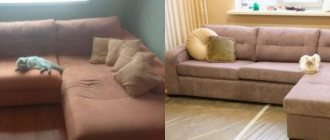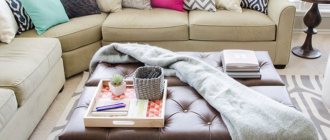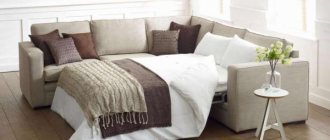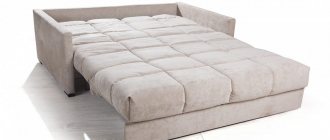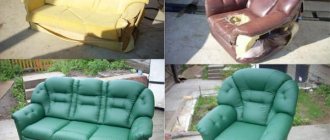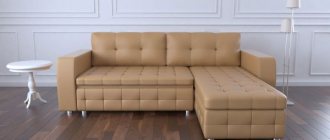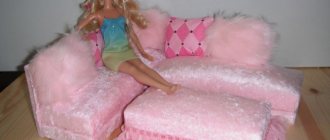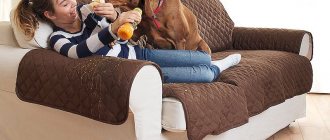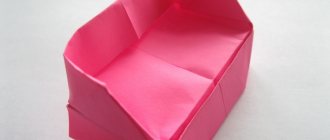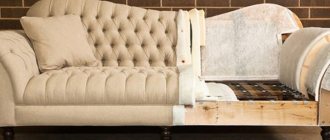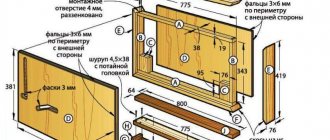Benefits of restoration
Many citizens are suspicious of restoring old furniture, although it has a lot of undeniable advantages. These include:
- saving money;
- independent choice of design;
- preserving memories associated with an antique item;
- improvement of weak points of the design to increase ease of use.
Budget savings
The main plus for which many decide to restore the sofa. Updating parts that have exhausted their service life costs much less, and the remaining money can be spent on more pleasant needs.
Antique Preservation
Old, antique things have always been valued. Why throw away a good, sturdy sofa that has a lot of memories attached to it? It’s easier to refresh its appearance and continue to use it for your pleasure. Perhaps in the future, the money saved on buying a sofa will be better used.
Choice of colors
When purchasing new furniture, the problem of choosing the right color scheme that harmoniously fits into the current interior of the room often arises. In case of restoration, it is much easier to buy fabric of the desired color, and this saves not only money, but also time.
Independent selection of material according to quality
Another undoubted advantage is the ability to choose the quality of the material used for restoration. An old sofa can be covered with more expensive fabric, which will significantly increase its appearance. At the same time, the price of a new product made from the same material will be many times higher.
Strengthening weak points
Buying new furniture always carries the danger of unexpected defects or design flaws that reduce the ease of use. All the disadvantages of old furniture are already known and they can always be eliminated by purchasing a couple of extra parts. This way you will update the appearance and strengthen the structure as a whole, with a minimum investment.
Why does a hole appear on the foam rubber?
Foam rubber sags not only due to improper treatment of the sofa. This is often due to the poor quality of the material itself, which quickly loses its elasticity and begins to compress and sag. The main reasons for pushing through the foam filler:
- poor quality material;
- dampening of the filler;
- excessive loads;
- knocking out dust;
- using furniture cleaners containing alcohol;
- proximity of heating devices;
- using a steam generator to clean a sofa.
It talks about how to choose the right foam rubber and how to replace it
here
.
Design
The advantages of restoration are more or less clear, now it’s time to understand the design of the sofa. This will allow you to determine the importance of a particular part, the amount of work to be done and the approximate cost of repair.
Frame
The basis of the structure, which bears the heaviest loads. Try not to purchase products made from chipboard. They are too fragile and quickly become unusable. A good frame is expensive, but the service life of such furniture is much longer.
Spring block base
An important detail responsible for ease of fit. If it is damaged or fails, the structure becomes inconvenient to use, and its working life is exhausted faster than usual.
Spring block
The spring block base provides the seat with elasticity and comfort. If it fails, the sofa will begin to make creaking sounds, wear out faster and spoil the upholstery from the inside. You shouldn't let your furniture get into this state. Timely repairs will solve many problems and contribute to further savings.
Felt or thick fabric
Felt is a natural material used in the assembly of sofas. Felt, or thick fabric, is used in old-style sofas as a protective layer and there are usually no problems with replacing them.
Polyurethane foam
Cheap and durable filler, widely used in the furniture industry. Polyurethane foam comes in two types:
- block;
- cast.
See also
How to properly lay tiles in the bathroom with your own hands
Note! To fill sofas, polyurethane foam is used, the density of which ranges from 30 to 40 kilograms per square meter. Fillings with a density below 30 kilograms are used only for the manufacture of decorative pillows.
Sintepon.
Synthetic filler made from non-woven fabric. It is used in budget designs due to its low cost.
Most often, it is not used as a basis for filling upholstery, but is combined with other, higher quality materials.
Upholstery fabric
The upholstery fabric is responsible for the decorative properties of the sofa and protects it from external influences. The higher quality and more expensive the upholstery, the longer the furniture retains its fresh, presentable appearance. There are a large number of materials for these purposes - you will always have plenty to choose the best option from.
What types of springs are there?
The spring block is one of the main “components” of the sofa, therefore, when it fails, there is an urgent need to replace it. In order to understand how to do this, it is necessary to understand in more detail the types of springs.
Table 2. Types of springs used in the manufacture of upholstered furniture
| View, illustration | Description |
| Snake | This is the simplest version of the spring design, but at the same time it has good strength. This type of spring can be called budget, and its main disadvantage is that with frequent use the seat quickly sag. |
| Bonnell | This is also a budget version of springs, which is also comfortable. Of the minuses, it is worth noting that over time the sofa begins to creak unpleasantly, therefore, even if one spring has become unusable, the block is often replaced. |
| Independent springs | The most reliable, comfortable and durable type of spring block. If we consider the most expensive option, then in the event of a breakdown it is possible to replace any part of the unit and continue using the sofa. |
Kinds
The complexity of restoring a sofa and its final cost largely depend on the type of furniture. Some models can be repaired quickly and without problems, while others will require a lot of resources. Let's figure out what types of sofas exist and what to expect if they break down.
Accessories
Regardless of the design of the sofa, the fittings are considered as a separate item. It consists of auxiliary structural elements, which also wear out over time. Sofa accessories include:
- legs;
- wheels.
They come in different sizes and shapes, and strength often depends on the material of manufacture.
Book
Comfortable and practical sofa models that have been popular since Soviet times. Pros of a sofa book:
- variability. Can be used as a sofa and as a bed;
- when assembled it has compact dimensions;
- has additional sections in which you can store bed linen or things.
Minuses:
- It cannot be placed close to the wall, since in this position it cannot be disassembled.
Eurobook
The sofa from the Eurobook series is considered a leader in terms of structural strength. This effect is achieved due to the simplicity of the design, which reduces the possibility of breakdown to a minimum. Advantages:
- easy to disassemble and assemble;
- large selection of sizes and shapes;
- no need to move away from the wall if there is a need for additional bed space.
Flaws:
- the price is higher than that of a book sofa.
Eurobook "Tick-tock"
The difference from the basic model is the mechanism for converting the sofa into a bed. You won't have to pull out the folding module, scratching the floor covering. The transformation process is carried out by weight, which makes the procedure silent and practical.
The only drawback of this design is the need to remove special pillows during transformation, which come with the sofa.
Accordion
A compact and practical sofa, which got its name because of the mechanism of transformation into a bed, reminiscent of the bellows of an accordion. Advantages of the model:
- small dimensions when folded;
- high orthopedic qualities;
- ease of use.
Flaws:
- There are many complex parts in the mechanism, some of which rub against each other during transformation. This significantly increases wear on the upholstery and the structure itself.
Click-clack
A type of sofa-book, equipped with a modified disassembly mechanism. The model has three working positions:
- sitting position;
- lying position;
- "chaise lounge" position.
The name comes from the characteristic sounds made by the furniture during transformation.
Dolphin
Universal furniture with an elongated corner part. It is used in the interior of spacious living rooms, but if necessary, it fits harmoniously into small rooms. Advantages of the model:
- the sleeping place is level, without changes;
- easy to disassemble and assemble.
Flaws:
- If low-quality, cheap materials are used during the assembly process, the product will quickly become unusable.
Materials
When buying a sofa, first of all, pay attention to the upholstery and filling. These materials are most subject to mechanical stress, which reduces the shelf life of the product.
Polyurethane foam
A material with high strength and low price. Not used as a main filler. In most modifications of sofas, both old and new, polyurethane foam acts as a gasket, combined with other fillers.
Holofiber
Synthetic material with the following distinctive features:
- Easily restores its original shape due to the porous structure of the substance.
- No harmful chemicals are used in the production process, making the material classified as environmentally friendly.
- Lasting.
- Long lasting.
Flaws:
- It requires proper care, otherwise it quickly loses its properties, becoming unusable.
Sintepon
A common synthetic material used, among other things, in the production of furniture. Among the advantages of synthetic winterizer are:
- cheap;
- when deformed, quickly returns to its basic shape;
- The fibers of the material are strong and, under strong impact, do not tear, but stretch.
See also
Rules for repairing a toilet cistern with your own hands at home
Minuses:
- may have a negative impact on health if manufactured using the adhesive method;
- When rubbed, it creates a static charge of electricity.
Vatnik
Used as flooring, combined with other fillers. Material Features:
- soft, pleasant to the touch;
- does not harm health;
- cheap;
- allows air to pass through well.
Flaws:
- not suitable as the main filler, since the fabric fibers have low elasticity. Because of this, a product made from quilted jacket does not restore its original shape well, which affects its appearance.
Periotec
Non-woven material of increased comfort, used as a filler in:
- mattresses;
- furniture;
- pillows;
- blankets
Pros:
- quickly recovers even with repeated deformation of the canvas;
- makes the furniture more comfortable;
- hypoallergenic;
- allows air to pass through well.
Flock
Textiles that have undergone chemical treatment, the front side of which is covered with a small pile. Many people confuse it with velor. Advantages:
- dense;
- soft;
- increased wear resistance;
- allows air to pass freely.
Negative qualities:
- substances that contain alcohol have a destructive effect on flock;
- highly electrified.
Velours
A budget alternative to velvet, used in the production of room furniture. It has a pleasant, soft fiber structure. The material is dense, which increases its wear resistance.
Jacquard
Expensive material made from various fabrics. Its main feature is considered to be its exceptional appearance and labor-intensive manufacturing process. A product covered with jacquard will decorate any home.
Chenille
A type of jacquard fabric that differs from regular fabric in the complexity of the thread weaving. Used for upholstery:
- chairs;
- armchairs;
- sofas
Tapestry
Fabric for upholstery, the threads of which are intertwined in a special way, creating a certain pattern on the surface of the material. Among the advantages are:
- beauty;
- durability;
- wide selection of colors and patterns.
Spring block repair
The spring block of the sofa is represented by a design of many twisted elements located next to each other, connected to each other at the top and bottom, and also secured along the entire perimeter with a rigid frame. The first sign of failure of the shock-absorbing system is the appearance of squeaking and sagging of the seat. Visually this is immediately noticeable.
Restoration of the spring block is carried out by replacing some elements or restoring connecting systems.
To access the inside of the sofa, you need to carefully remove the upholstery using an anti-stapler and remove the soft backing made of felt and foam rubber.
As soon as the mechanism becomes available for inspection and manipulation, problem areas and methods for eliminating them are identified:
- If the twisted elements are disconnected from each other or the frame, restore the fastening using thin hardened wire and pliers. The sharp edges of the material are bitten off and directed downward.
- If the spring breaks or loses its elasticity, purchase the part and replace it.
- If the entire shock-absorbing system of the sofa has become unusable, replacement of the spring unit is required or the selection of another design, more reliable from the available furniture products.
If the inspection revealed weak points in the parts of the block, repairing the spring in the sofa is impractical. After a short period of time it will break anyway. It's better to replace it immediately.
Required materials and tools
In a situation where you decide to restore the sofa yourself, do not forget to prepare properly. For repair you will need:
- electric jigsaw;
- construction adhesive;
- stapler for furniture;
- screwdriver;
- pliers;
- upholstery material and filler.
Tapestry, velor or suede
Professionals who have been involved in furniture restoration for a long time advise choosing one of the following materials for upholstery:
- tapestry;
- suede;
- velours.
They have the best characteristics in their price segment, and everyone will find an option to suit their pocket.
Simple plain fabric
Used to create a fastening cover. Any fabric you can afford will do.
Special furniture foam rubber
Used as a filler for a sofa. It is considered the best option in terms of price and quality ratio. If you have broad financial capabilities, you can purchase other, more expensive material.
Thick fabric
Thick fabric, such as carpet, is used to protect the box spring. You will need a large piece of fabric, since protection is required on both sides.
Note! Try to buy high-quality materials, otherwise another restoration will soon be required.
Construction adhesive
Glue from any manufacturer will do. During the restoration process, no more than one tube of the substance will be useful, so there is no need to make large supplies. Glue is used to carefully fix the material.
Furniture stapler
A furniture stapler is used to secure the upholstery of a sofa. The stapler must come with at least one clip of staples.
If you don’t have a stapler, you’ll have to buy it in a store or ask your neighbors for the tool.
Durable nylon thread
A sofa cover made from the upholstery material of your choice will be sewn with nylon thread. The thread should come with a strong needle.
Spanner, pliers and screwdriver
They will be useful when working with the mechanical parts of the sofa, in case of replacement or adjustment. Any set of these tools sold at a hardware store will do.
Jigsaw
An indispensable thing when working with wooden parts of the sofa. If you need to saw off, trim or correct something, you won’t find a better tool.
It is advisable to purchase it for permanent use, as it will come in handy many times in the future.
Replacing the filler
New foam for filling the sofa
The loss of elasticity and resilience is associated either with the spring block or with the filler. Also, replacement of the filler must be carried out due to the appearance of unpleasant odors and breakthrough of the upholstery from the inside.
Required for work
- Construction stapler and staples.
- Screwdriver and screwdriver.
- Filler.
Repair algorithm
- Carefully disassemble the sofa into its component elements.
- Carefully remove the trim.
- Take out the old foam.
- Install a new one with a total thickness of 35-40 mm.
- Secure the filler with glue or staples.
Advice
- Replace the filling together with the upholstery. The amount of total expenses for independent work will not exceed 3,000 rubles.
Replacing upholstery for an Italian sofa
Instructions
After all the materials for restoration have been purchased and the tools have been prepared, it’s time to move on to the repair itself. This process is not complicated, you just need to be careful and consistently follow all the steps described in the instructions.
Checking and repairing upholstered furniture frames
The first step in restoring a sofa is to check all its components for integrity and functionality. If any boards are rotten or cracked, try to replace them.
This approach will allow you to properly repair old furniture, after which it will serve for many more years.
Dismantling and inspection
After checking the frame, the process of dismantling individual structural elements begins, such as:
- armrests;
- sofa backs;
- upholstery;
- filler;
- springs
See also
Step-by-step instructions on how to quickly disassemble a computer chair with your own hands
Side armrests
In most models, the fastener is located on the inside, and to get to it you will need:
- hex socket wrench;
- pliers.
If these tools are available, there will be no difficulties with dismantling.
Seats and backrests
The seats and backrests are fixed using special fasteners to the lower frame of the sofa. The tools you prepared before starting the repair of the product will help you cope with the fasteners.
Old upholstery, staples
The old upholstery is attached to the wooden parts of the sofa using special staples. They must be carefully removed, after which removing the upholstery will not be difficult.
Old filler
Once the upholstery is removed, access to the sofa filling will open. It is advisable to immediately replace it with a new one, but if it is in acceptable condition, you can leave the old filling.
Springs, checking their condition
Once the filler is removed, we move on to evaluating the springs. If the inspection result shows a satisfactory condition, it is enough to clean and coat the old parts with lubricant.
If some springs are damaged, be sure to replace them with new ones.
Checking the condition of the chipboard
Often it is the chipboard sheets that become unusable first. Replace damaged parts of the structure or leave the old ones if their condition allows reuse.
Repair and replacement of old elements
After all the components of the sofa have been dismantled, you can proceed to repair and replacement of old parts. Subject to inspection:
- base for a spring block;
- spring block;
- mechanisms responsible for disassembling the sofa;
- slats.
Spring block base
The base for the spring block is completely changed if any defects or malfunctions are detected. Fastening to the block is carried out using a stapler. If you couldn’t find a stapler, take:
- thin cloves;
- steel wire.
We make brackets from them and attach the springs.
Spring block
To repair a spring block, you must:
- replace faulty springs;
- cover each side of the block with thick fabric, which is attached to the part using a nylon thread.
Note! The edges of the fabric are folded inward.
Case and cover
Fastening the cover and covering the frame with upholstery is carried out using construction glue and a stapler. Don't forget to return the old filler or replace it with a new one.
Mechanism repair
Repairing sofa mechanisms has its own nuances, depending on which operating principle is used:
- folding;
- roll-out
In roll-out ones, the roller most often fails, and in folding ones, the springs fail, which over time lose their shape and burst.
Lamels
Reasons for lamella failure:
- poor quality of material;
- high load on a separate section.
Damaged strips are bent until they completely come out of the fixing grooves, after which a new part is installed in their place.
How to disassemble a sofa
Before disassembling, you need to prepare small containers for storing bolts, nuts, screws and removed staples . It is recommended to wear gloves to avoid injury to your palms.
Dismantling must be performed in the following sequence:
- one by one , and then disconnect them from the body . If the armrests are damaged, remove them too.
- Separate the soft part and the frame. This can be done alone, but it is better to attract an assistant, since the top is quite heavy and bulky. Moving it yourself is difficult and dangerous.
- Remove the staples holding the fabric down . It is better to pry them off with a screwdriver and then pull them out with pliers.
- Remove the fabric. If it is in good condition, send it to the wash. The damaged material will be used to take measurements for a new one.
- Remove the filler and assess its condition . Keep the good one and throw away the used one.
- Inspect the springs: if they are still in order, leave them; if they are worn out or bent, they will have to be replaced.
After work, a lot of removed staples remain. They can be assembled simply and quickly using a magnet.
Decoration
Decorating the sofa is done using:
- creating beautiful pillows;
- carriage screed;
- figured solid wood.
Beautiful pillows
Pillows are made independently, from leftover material, or purchased in a store. It all depends on your financial capabilities.
Carriage tie
The back of the sofa is decorated with a carriage tie. To do this, small circles are cut out of the foam rubber during stuffing, after which buttons will be sewn in their place. This will help prevent the material from curling. Afterwards the frame is covered with fabric and decorative elements are sewn on.
Figured wood
Wooden armrests can be decorated by gluing solid wood onto them. Such a sofa will look much more beautiful and will last longer than usual.
Causes of failure
If the sofa has collapsed, then it is worth identifying the original source of the problem.
Usually the sofa sags in the middle, which greatly reduces the level of comfort.
Causes:
- the pillows are wrinkled, the reason is in the filler;
- the spring block sank;
- the frame bent.
To identify the cause of the hole, it is enough to visually evaluate each individual element. Sofa owners face such problems during long-term and active use of the furniture.
All cases can be corrected at home on our own. It is important to prepare all the necessary materials in advance and be patient.
Features of choice
When choosing fabric for lining and padding, it is worth considering some nuances, which we will discuss below.
Upholstery fabrics
When choosing your upholstery fabric, keep the following details in mind:
- the fabric should be easy to clean from dirt;
- the fabric should look attractive;
- Resistant to exposure to ultraviolet radiation and moisture.
Filler
When constantly using furniture for its intended purpose, choose:
- latex;
- durafil;
- spring block;
- holofiber.
Padding
This relatively new concept includes not only the replacement of upholstery, but also: a complete repair of the frame, replacement of foam rubber, locks, spring blocks, everything that is required. In essence, reupholstery is a major overhaul of upholstered furniture, as a result of which you will receive a new interior element made to your taste.
Major repairs allow you to save even the most “dead” furniture
Required tools and materials
In order for the work of reupholstering upholstered furniture to proceed comfortably, smoothly and without unnecessary nerves, you need to prepare the necessary tools in advance.
Tools for disassembly and assembly work
- A large flat-head screwdriver and pliers are used to pick up and pull out old staples.
- A Phillips or flat-head screwdriver that matches the slot size of the screw heads securing the lock to the frame.
- Set of wrenches for nuts and bolts.
Almost all upholstered furniture frames are bolted, so you can’t do without a set of keys
- Tape measure - take the necessary measurements when replacing body parts.
- Stapler - construction or pneumatic. The second is preferable because, without effort on your part, it drives long, strong staples deep into the wood of the frame, even through several layers of fabric.
- Staples - from 6 mm to 10 mm depending on the thickness and density of the selected upholstery fabric.
- Garbage bags (larger and denser).
To sew new covers you will need:
- New upholstery fabric - the choice in stores is mind-boggling, choose according to taste and cost. In order not to be mistaken with the footage, sketch out approximate details before purchasing. Take into account the standard width of the roll - up to 145 cm (including the edging of the edges of the fabric) and the location of the patterns relative to the pile and shine of the material.
- Lining fabric for padding the back surfaces of the back and seat. This is not necessary, but a layer of lining will protect the furniture from dust getting inside, and the cost of lining material is low. Therefore, it is better not to neglect this simple operation.
- Sharp scissors, preferably special tailor's scissors for cutting.
When cutting new covers, tailor's scissors will be simply irreplaceable.
- Crayons or thin pieces of soap.
- Threads - no less than No. 10, and better - special reinforced ones for rigid fabrics.
- Meter ruler.
- Paper for patterns if you are going to modify the appearance of the product: change the shape of the legs, back and seats.
- Sewing machine.
